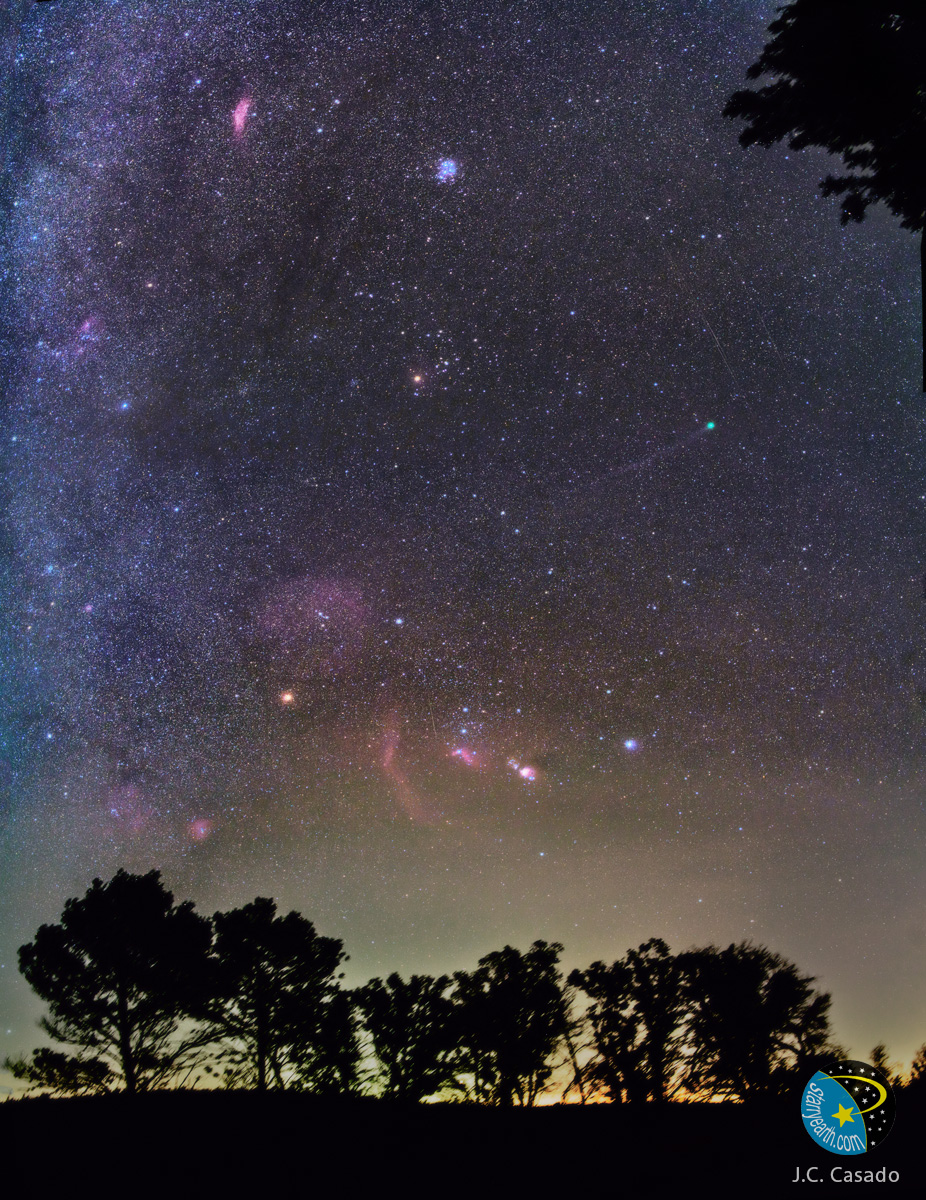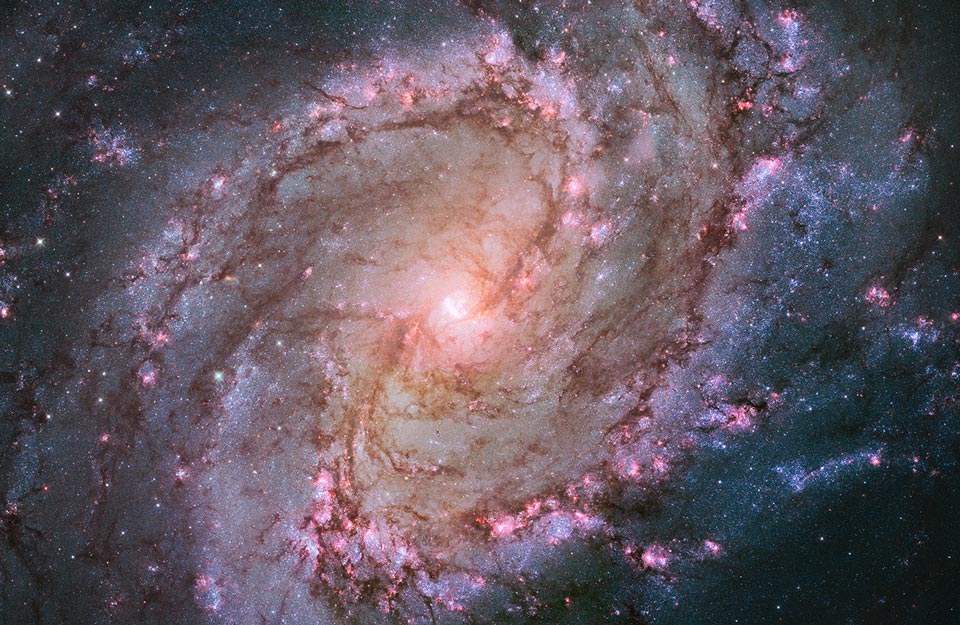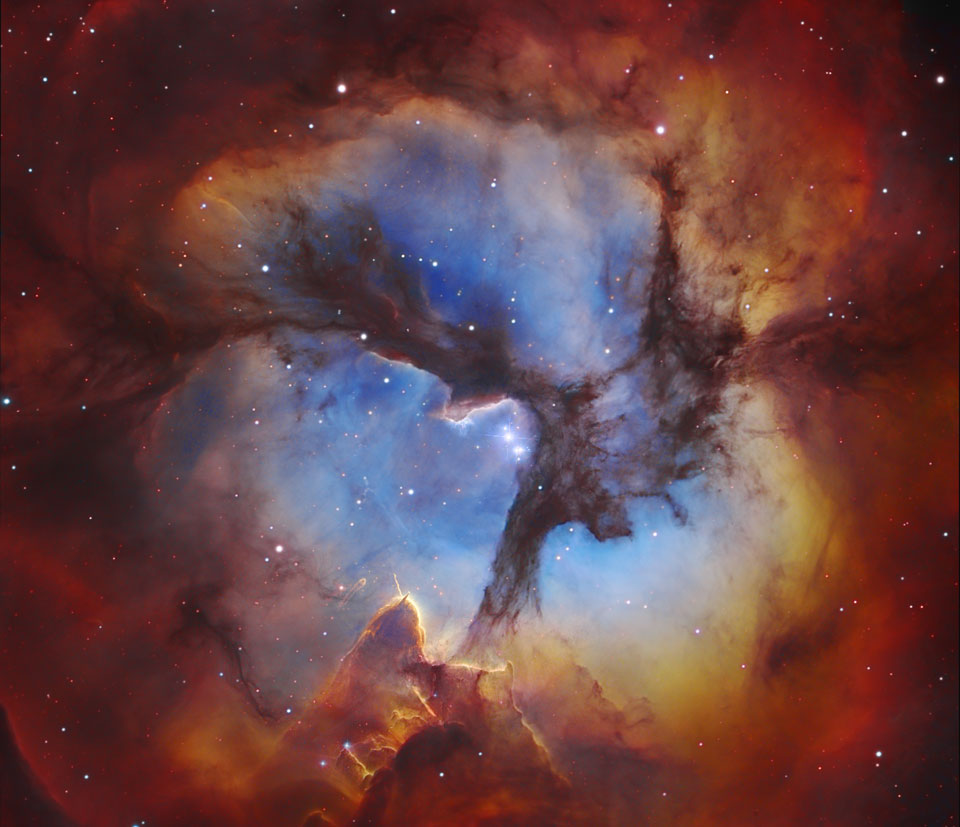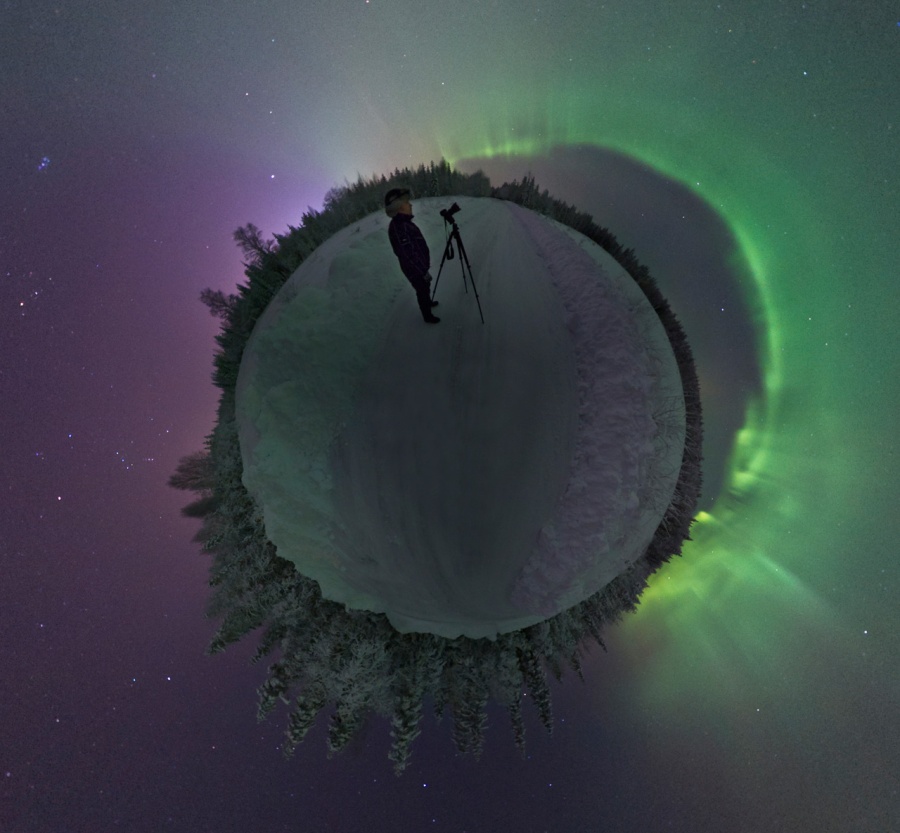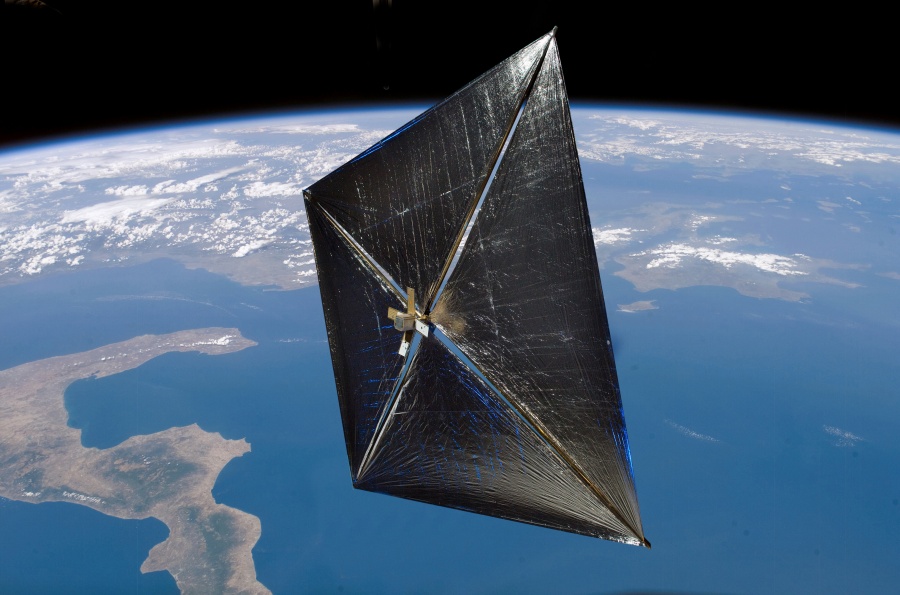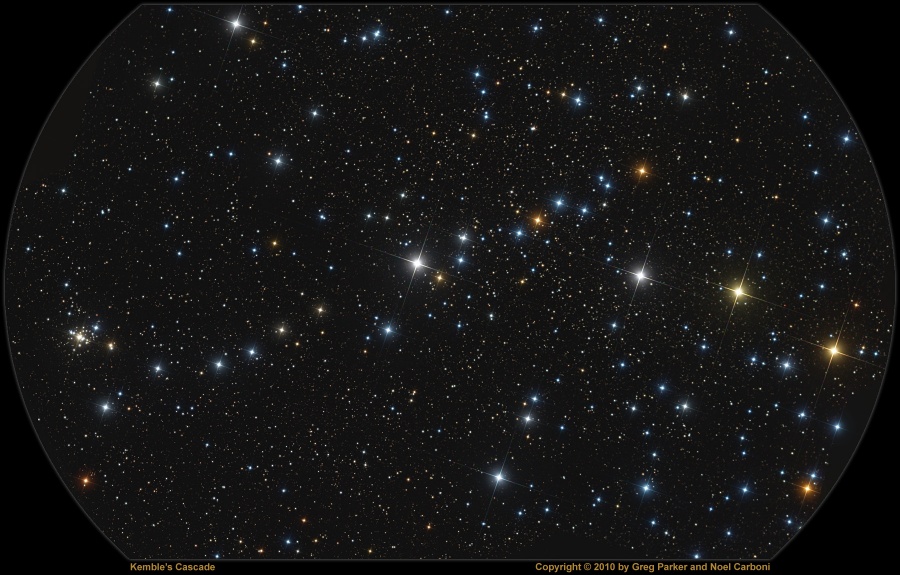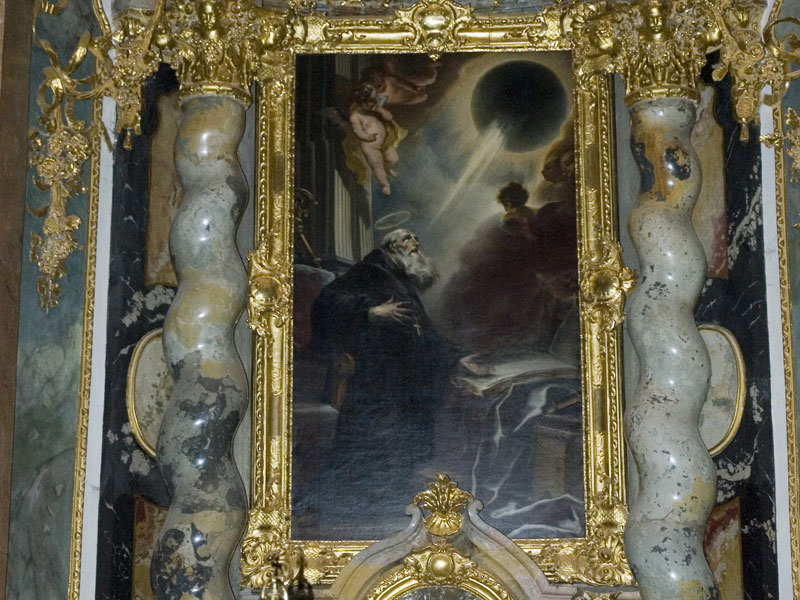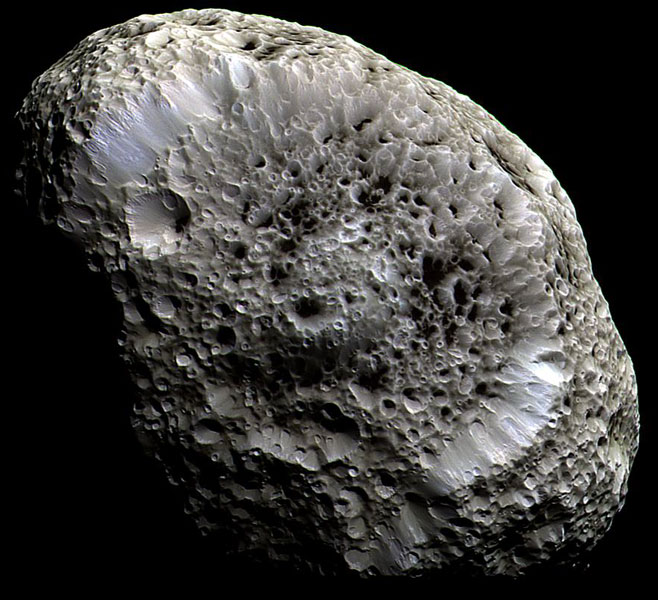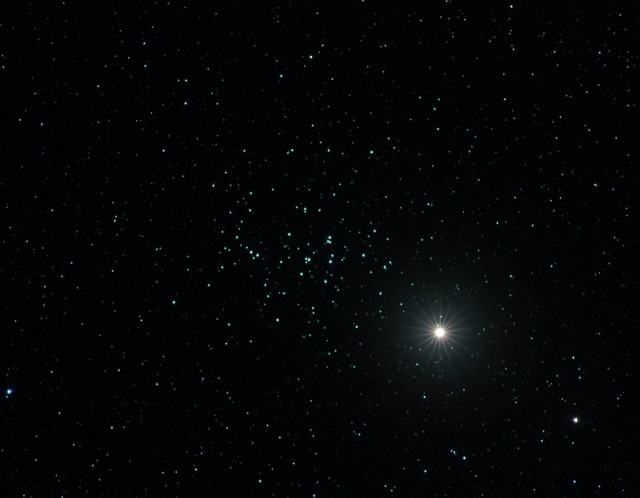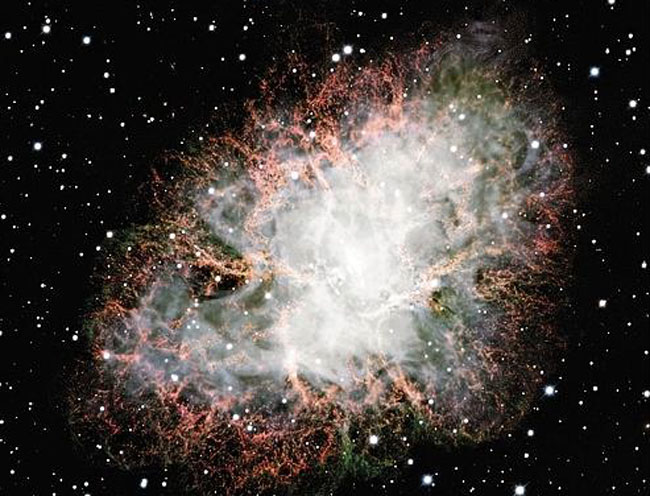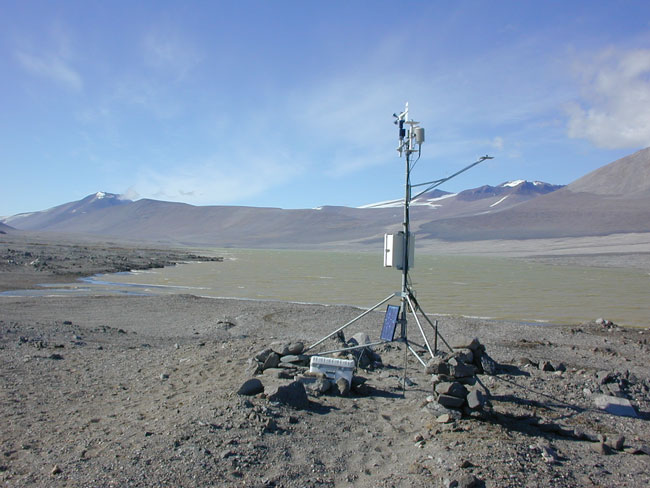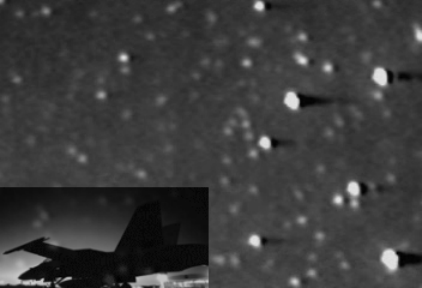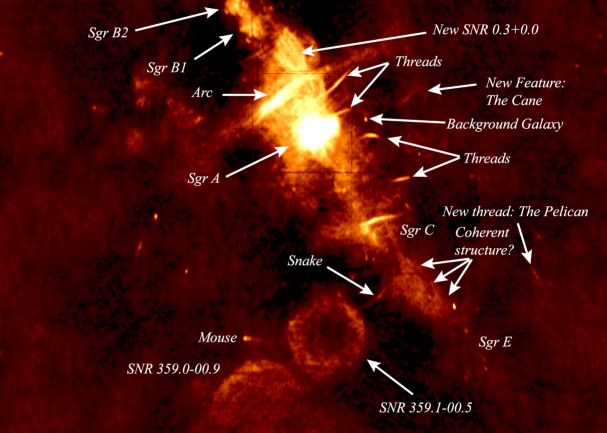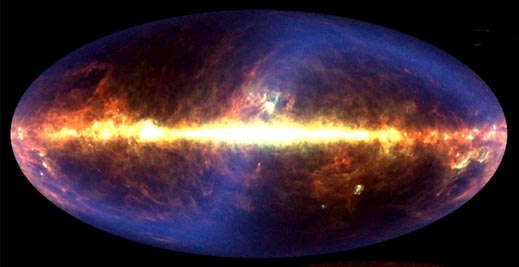| << Previous | Index | Next >> |
2015 Which of these night sky icons can you find in this beautiful and deep exposure of the northern winter sky? Skylights include the stars in Orion's belt, the Orion Nebula, the Pleiades star cluster, the bright stars Betelgeuse and Rigel, the California Nebula, Barnard's Loop, and Comet Lovejoy. The belt stars of Orion are nearly vertical in the central line between the horizon and the image center, with the lowest belt star obscured by the red glowing Flame Nebula. To the belt's left is the red arc of Barnard's Loop followed by the bright orange star Betelgeuse, while to the belt's right is the colorful Orion Nebula followed by the bright blue star Rigel. The blue cluster of bright stars near the top center is the Pleiades, and the red nebula to its left is the California nebula. The bright orange dot above the image center is the star Aldebaran, while the green object with the long tail to its right is Comet C/2014 Q2 (Lovejoy). The featured image was taken about two weeks ago near Palau village in Spain.
2014 M83 is one of the closest and brightest spiral galaxies on the sky. Visible with binoculars in the constellation of Hydra, majestic spiral arms have prompted its nickname as the Southern Pinwheel. Although discovered 250 years ago, only much later was it appreciated that M83 was not a nearby gas cloud, but a barred spiral galaxy much like our own Milky Way Galaxy. M83, pictured above by the Hubble Space Telescope in a recently released image, is a prominent member of a group of galaxies that includes Centaurus A and NGC 5253, all of which lie about 15 million light years distant. Several bright supernova explosions have been recorded in M83. An intriguing double circumnuclear ring has been discovered at the center of of M83.
2013
2012 Illuminated by an eerie greenish light, this remarkable little planet is covered with ice and snow and ringed by tall pine trees. Of course, this little planet is actually planet Earth, and the surrounding stars are above the horizon near Östersund, Sweden. The pale greenish illumination is from a curtain of shimmering Aurora Borealis also known as the Northern Lights. The display was triggered when a giant solar coronal mass ejection (CME) rocked planet Earth's magnetosphere on January 24th and produced a strong geomagnetic storm. Northern hemisphere skygazers will also recognize the familiar orientation of stars at the left, including the Pleiades and Hyades star clusters and the stars of Orion. Increasing solar activity has caused recent auroral displays to be wide spread, including Aurora Australis, the Southern Lights, at high southern latitudes.
2011 Featured in this artist's illustration, NASA's NanoSail-D finally unfurled a very thin, 10 square meter reflective sail on January 20th, becoming the first solar sail spacecraft in low Earth orbit. Often considered the stuff of science fiction, sailing through space was suggested 400 years ago by astronomer Johannes Kepler who observed comet tails blown by the solar wind. Modern solar sail spacecraft designs, like NanoSail-D or the Japanese interplanetary spacecraft IKAROS, rely on the small but continuous pressure from sunlight itself for thrust. Glinting in the sunlight as it circles planet Earth, the NanoSail-D solar sail will periodically be bright and easily visible to the eye. In fact, skygazers are urged to participate in an ongoing contest to capture images of NanoSail-D. The images will help NASA monitor the satellite before it reenters the atmosphere in April or May.
2010 An asterism is just a recognized pattern of stars that is not one the 88 official constellations. For example, one of the most famous (and largest) asterisms is the Big Dipper within the constellation Ursa Major. But this pretty chain of stars, visible with binoculars towards the long-necked constellation of Camelopardalis, is also a recognized asterism. Known as Kemble's Cascade, it contains about 20 stars nearly in a row, stretching over five times the width of a full moon. Tumbling from the upper right to lower left in the picture, Kemble's Cascade was made popular by astronomy enthusiast Lucian Kemble. The bright object at the lower left is the relatively compact open cluster of stars, NGC 1502.
2009
2008 Is this painting the earliest realistic depiction of a total eclipse of the Sun? Some historians believe it is. The above painting was completed in 1735 by Cosmas Damian Asam, a painter and architect famous in early eighteenth century Germany. Clearly drawn is not only a total solar eclipse, but the solar corona and the diamond ring effect visible when sunlight flows only between mountains on the Moon. The person depicted viewing these eclipse phenomena is St. Benedict. Roberta J. M. Olson and Jay Pasachoff have hypothesized that Asam himself may have seen first hand one or all of the total solar eclipses of May 1706, 1724, and 1733. Many facts about our astronomical universe that are taken for granted today have been known -- or accurately recorded -- only during the last millennium. Asam's painting currently hangs in Weltenburg Abbey in Bavaria, Germany.
2007 What lies at the bottom of Hyperion's strange craters? Nobody knows. To help find out, the robot Cassini spacecraft now orbiting Saturn swooped past the sponge-textured moon in late 2005 and took an image of unprecedented detail. That image, shown above in false color, shows a remarkable world strewn with strange craters and a generally odd surface. The slight differences in color likely show differences in surface composition. At the bottom of most craters lies some type of unknown dark material. Inspection of the image shows bright features indicating that the dark material might be only tens of meters thick in some places. Hyperion is about 250 kilometers across, rotates chaotically, and has a density so low that it might house a vast system of caverns inside.
2006 If you can find Saturn in tonight's sky, then you can also find M44, popularly known as the Beehive star cluster. In fact, with a pair of binoculars most casual skygazers should find it fairly easy to zero in on this celestial scene. Saturn is at opposition - opposite the Sun in Earth's sky - so, the bright planet rises in the east at sunset and is visible throughout the night. Near the stationary part of its wandering path through the heavens, Saturn will obligingly linger for a while in the vicinity of M44 in the relatively faint constellation Cancer. Seen here in a photograph from January 25, Saturn (lower right) is strongly overexposed with the stars of M44 swarming above and to the left. The picture approximately corresponds to the view when looking through a typical pair of binoculars. Saturn is about 64 light-minutes from our fair planet while M44, one of the closest star clusters, is around 600 light-years away.
2005 What do you call a group of black holes ... a flock, a brace, a swarm? Monitoring a region around the center of our Galaxy, astronomers have indeed found evidence for a surprisingly large number of variable x-ray sources - likely black holes or neutron stars in binary star systems - swarming around the Milky Way's own central supermassive black hole. Chandra Observatory combined x-ray image data from their monitoring program is shown above, with four variable sources circled and labeled A-D. While four sources may not make a swarm, these all lie within only three light-years of the central supermassive black hole known as Sgr A* (the bright source just above C). Their detection implies that a much larger concentration of black hole systems is present. Repeated gravitational interactions with other stars are thought to cause the black hole systems to spiral inward toward the Galactic Center region.
2004 This is the mess that is left when a star explodes. The Crab Nebula, the result of a supernova seen in 1054 AD, is filled with mysterious filaments. The filaments are not only tremendously complex, but appear to have less mass than expelled in the original supernova and a higher speed than expected from a free explosion. The above image, taken by the Canada-France-Hawaii Telescope (CFHT), is in three colors chosen for scientific interest. The Crab Nebula spans about 10 light-years. In the nebula's very center lies a pulsar: a neutron star as massive as the Sun but with only the size of a small town. The Crab Pulsar rotates about 30 times each second.
2003 A lake hidden beneath 19 meters of ice and gravel has been found near the bottom of the world that might contain an ecosystem completely separate from our own. In a modern version of Sir Arthur Conan Doyle's classic book Lost World, scientists are now plotting a mission to drill down into the lake and take out a small part to see what's there. Lake Vida, buried under Antarctic ice for over 2,500 years, is liquid only because of its high salt content. Previously, scientists drilled to within a few meters of the lake and indeed found frozen microbes. Their existence bolsters speculation that similar microorganisms could be found in frozen brine beneath the surface of Mars. If living organisms are found in Lake Vida, they may give an indication that life might even still exist under similar frozen ice-sheets, such as under the larger Lake Vostok, parts of Mars, and even moons of Jupiter such as Europa. Pictured above, a robot meteorological station continues to monitor surface conditions over the ice-sealed lake.
2002 What would it be like to stand on the surface of another world, to look all around you, and to try to figure out how this world got there? To get an idea, scroll right. In 1972 during the Apollo 17 mission, astronauts Harrison Schmitt and Eugene Cernan found out first hand. In this case, the world was Earth's own Moon. In one of the more famous panoramas taken on the Moon, the magnificent desolation of the barren Moon is apparent. Visible are rocks, hills, craters, the lunar rover, and astronaut Schmitt preparing to take a soil sample. A few days after this image was taken, humanity left the Moon and has yet to return. An interactive version of the above image can be found here.
2001 Our Earth is not at rest. The Earth moves around the Sun. The Sun orbits the center of the Milky Way Galaxy. The Milky Way Galaxy orbits in the Local Group of Galaxies. The Local Group falls toward the Virgo Cluster of Galaxies. But these speeds are less than the speed that all of these objects together move relative to the cosmic microwave background (CMB). In the above all-sky map, radiation in the Earth's direction of motion appears blueshifted and hence hotter, while radiation on the opposite side of the sky is redshifted and colder. The map indicates that the Local Group moves at about 600 kilometers per second relative to this primordial radiation. This high speed was initially unexpected and its magnitude is still unexplained. Why are we moving so fast? What is out there?
2000 In an era of blossoming ground and space-based observatories, astronomers are also pushing the envelope with airborne instrumentation - successfully capturing an asteroid occultation from a high performance jet aircraft. This blinking animation represents two digitized frames from inflight data of asteroid number 308, Polyxo, passing in front of or occulting a faint star near the center of the field. The camera used, known as the SouthWest Ultraviolet Imaging System (SWUIS) -A, was mounted in the cockpit of a NASA F/A-18 jet (inset lower left). A former US Navy fighter aircraft, the F/A-18 was able to maneuver to the precise position to record the occultation while cruising above clouds and much of Earth's obscuring atmosphere. Using the SWUIS-A data to time the occultation will reveal the size of the asteroid which is otherwise too small to be imaged by even the orbiting Hubble Space Telescope. Future SWUIS-A airborne missions may include a hunt for Vulcanoids, a suspected population of small asteroids circling the Sun inside the orbit of Mercury.
1999 Tuning in to the center of our Milky Way galaxy, radio astronomers explore a complex, mysterious place. A premier high resolution view, this startlingly beautiful picture covers a 4x4 degree region around the galactic center. It was constructed from 1 meter wavelength radio data obtained by telescopes of the Very Large Array near Socorro, New Mexico, USA. The galactic center itself is at the edge of the extremely bright object labeled Sagittarius (Sgr) A, suspected of harboring a million solar mass black hole. Along the galactic plane which runs diagonally through the image are tortured clouds of gas energized by hot stars and round-shaped supernova remnants (SNRs) - hallmarks of a violent and energetic cosmic environment. But perhaps most intriguing are the arcs, threads, and filaments which abound in the scene. Their uncertain origins challenge present theories of the dynamics of the galactic center.
1998 Three major sources contribute to the far-infrared sky: our Solar System, our Galaxy, and our Universe. The above image, in representative colors, is a projection of the entire infrared sky created from years of observations by the robot spacecraft COBE. Our Solar System is evidenced most prominently by the S-shaped blue sash called zodiacal light, created by small pieces of rock and dust orbiting between the Sun and Jupiter. Our Galaxy is evidenced by the bright band of light that crossed the middle of the image, created mostly by dust that laces the disk of our Milky Way. Close inspection of the image reveals that the background is not completely dark, indicating that our Universe itself provides a diffuse glow, created by the dust left over from the star formation throughout the Universe.
1997 Many stars form in clusters. Two types of star clusters are visible in our Milky Way Galaxy: open clusters and globular clusters. Open clusters like M50, shown above, typically contain hundreds of stars, many of which are bright, young, and blue. In fact, most of the bright blue stars in the above picture belong to M50, but most of the dimmer, red stars do not. M50 lies about 3000 light-years from Earth and is about 20 light years across. Open clusters tend to have irregular shapes and are mostly found in the plane of our Galaxy.
1996 In December of 1993 astronauts Story Musgrave and Jeffrey Hoffman performed the orbiting repairmans' ballet 400 miles above the Earth. They are seen in this photo perched at the end of the Space Shuttle Endeavour's robotic arm making final repairs to the four story tall Hubble Space Telescope. The coast line of western Australia is visible below. The complex and highly successful repair mission allowed HST to see into the Universe with unprecedented clarity.
| << Previous | Index | Next >> |
